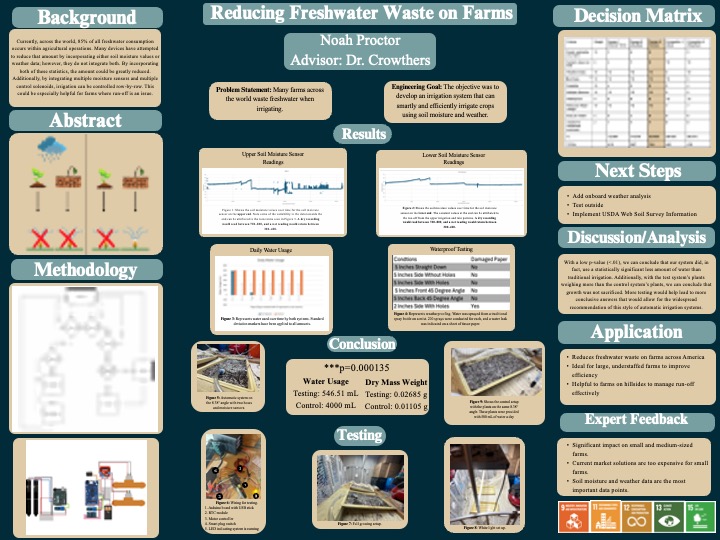STEM is an amazing class where students choose a project they’re interested in and work on it for the first five months of the year. Through this process, students learn valuable skills like writing grant proposals and thesis papers, as well as maintaining scientific notebooks for documentation. Extensive comments from teachers and peers make the process easier. Independent STEM projects run from before school starts until February 20th, when students present their work. These projects make students eligible for competitions like the Worcester Regional Science and Engineering Fair or the Massachusetts Science and Engineering Fair.
Reducing Freshwater Waste on Farms Through Automatic Irrigation
Overview
Farms across the United States often overuse freshwater, which can be very dangerous to the climate and the environment. To address this issue, this project utilizes an Arduino Giga to monitor soil and weather conditions. By analyzing these metrics, the system determines whether watering is necessary, helping to reduce water usage while still maintaining healthy plant growth. This project is valuable because it offers an efficient, data-driven approach to irrigation, helping farmers conserve water without compromising crop yield. The code can be found on GitHub here.
Abstract
In the United States, many large-scale farms use some form of external irrigation, whether through drip irrigation or overhead sprinklers. However, these methods can be highly inefficient and result in significant water waste. Because of this, various automated irrigation systems have been developed to minimize freshwater consumption in agriculture. Additionally, farms on hillsides can pose additional challenges, as water will flow downhill, causing the soil at the bottom to become moister compared to the soil at the top, further wasting water. While many systems incorporate some components, such as weather or soil data, they often fail to integrate both data types. This project introduces a new irrigation system that integrates weather and soil data while accounting for topographical variations by utilizing multiple solenoid control valves and capacitive soil moisture sensors. The multiple soil moisture sensors and solenoid control valves will allow us to smartly irrigate the different levels independently. This approach offers a more efficient and sustainable water management solution that shows a nearly 50% reduction in water used compared to traditional irrigation systems. This system could be transferred to large-scale agricultural operations and significantly reduce their water footprint. Keywords: Soil Moisture Sensor, Arduino, Weather, Solenoid Valve, Irrigation
Graphical Abstract
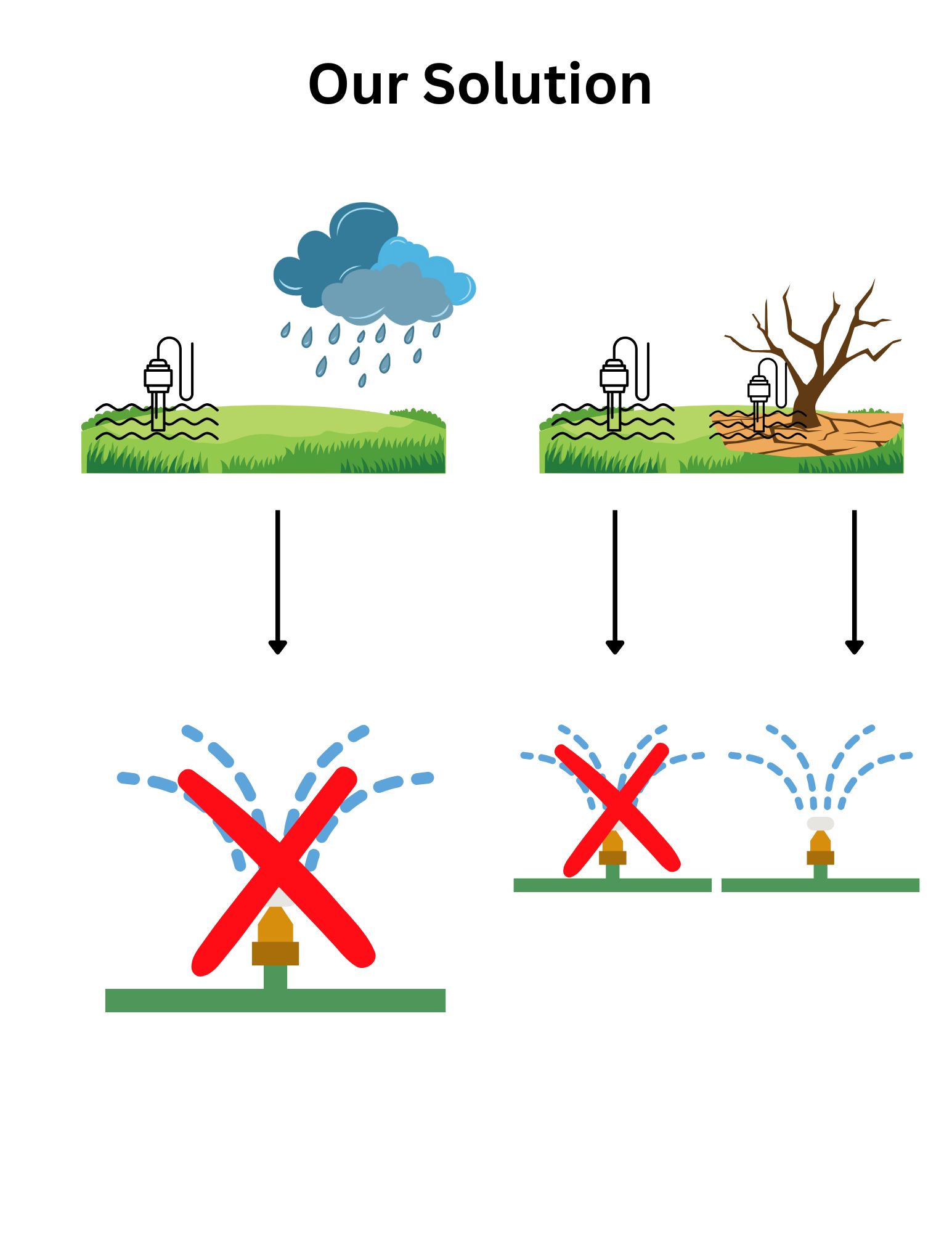
Problem Statement
Farms across the world overconsume freshwater in their irrigation practices.
Engineering Objective
Develop a smart irrigation system that implements weather and soil metrics to reduce water usage while maintaining plant growth.
Background Infographic
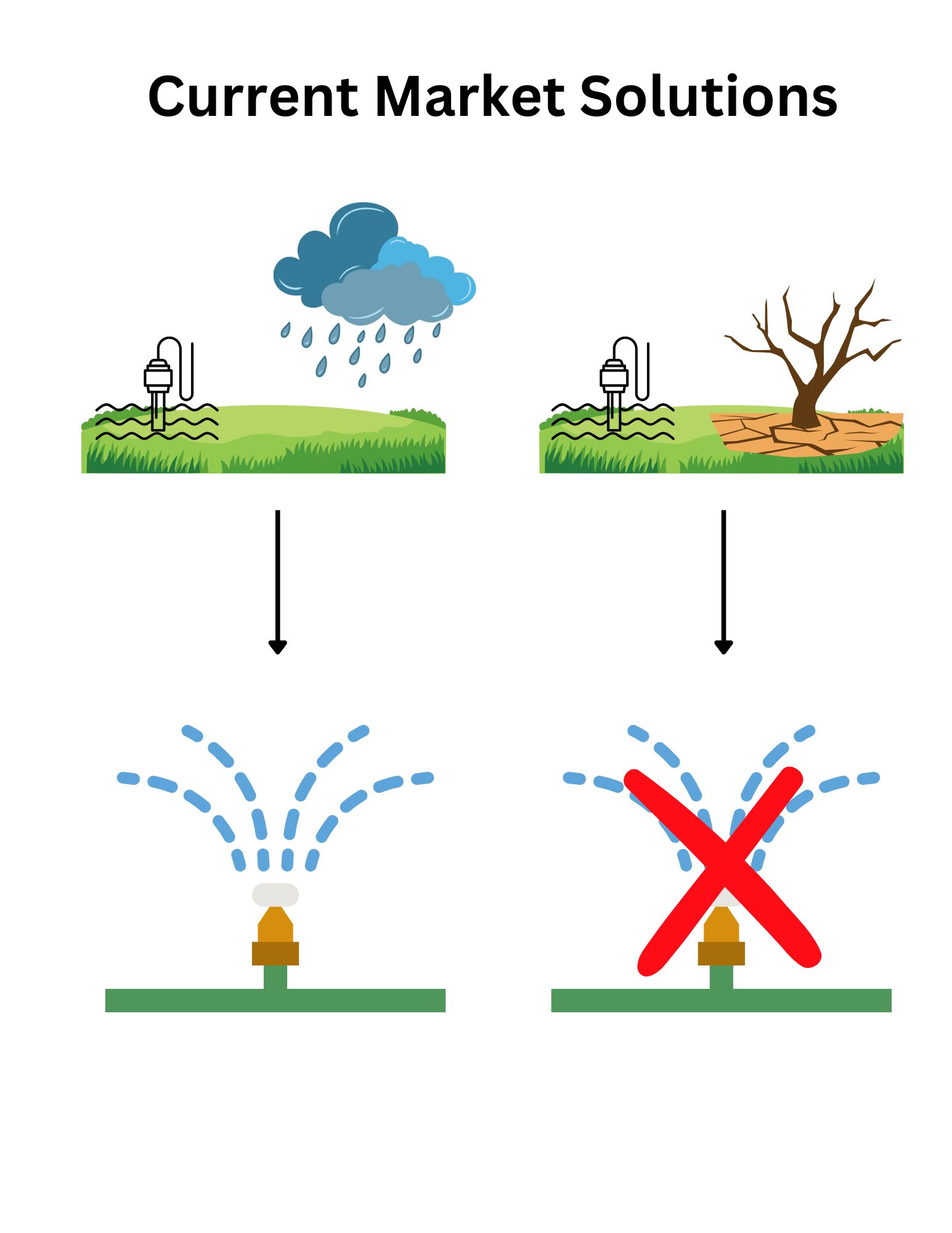
Background
Procedure Infographic
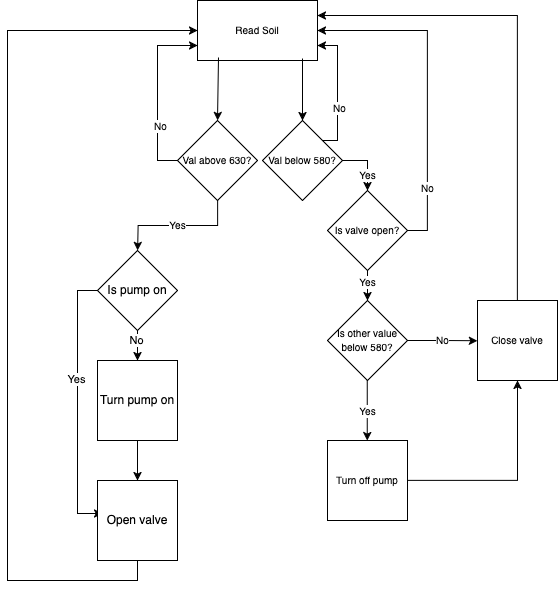
Procedure
Graphs
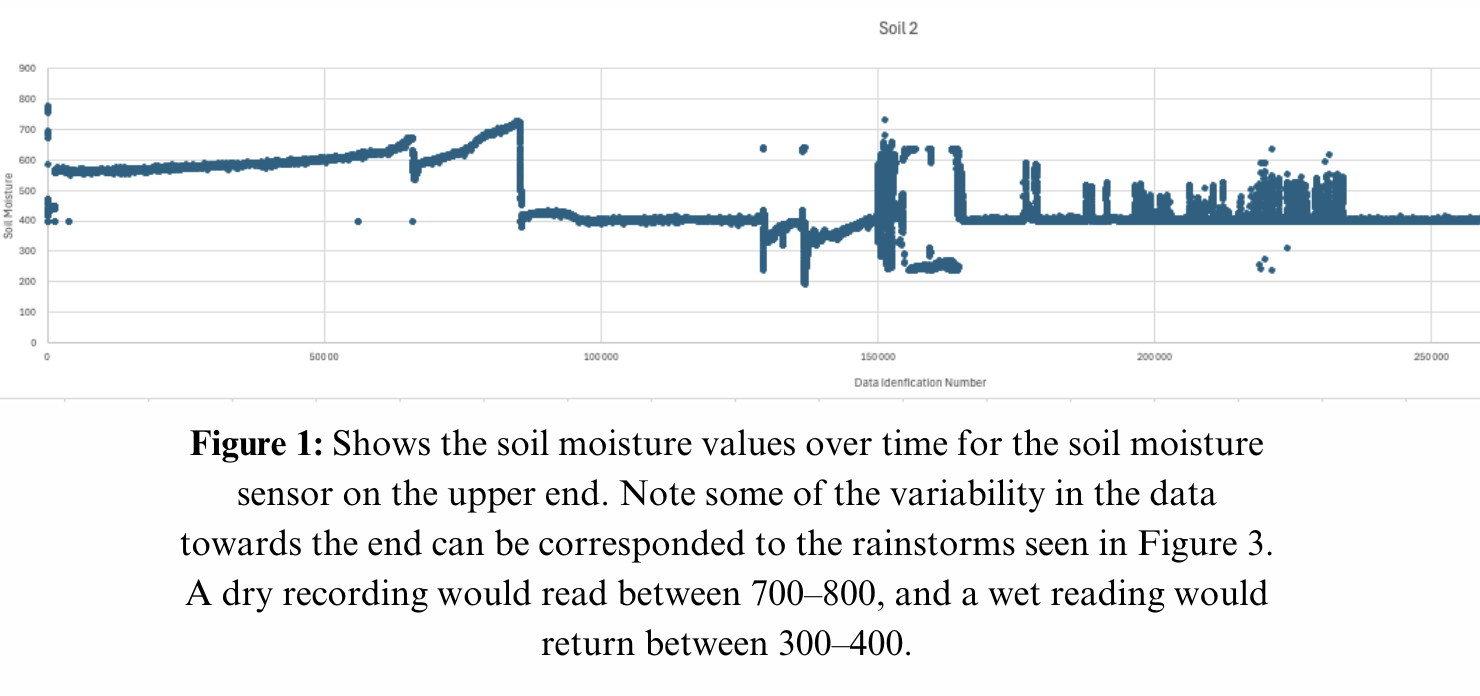
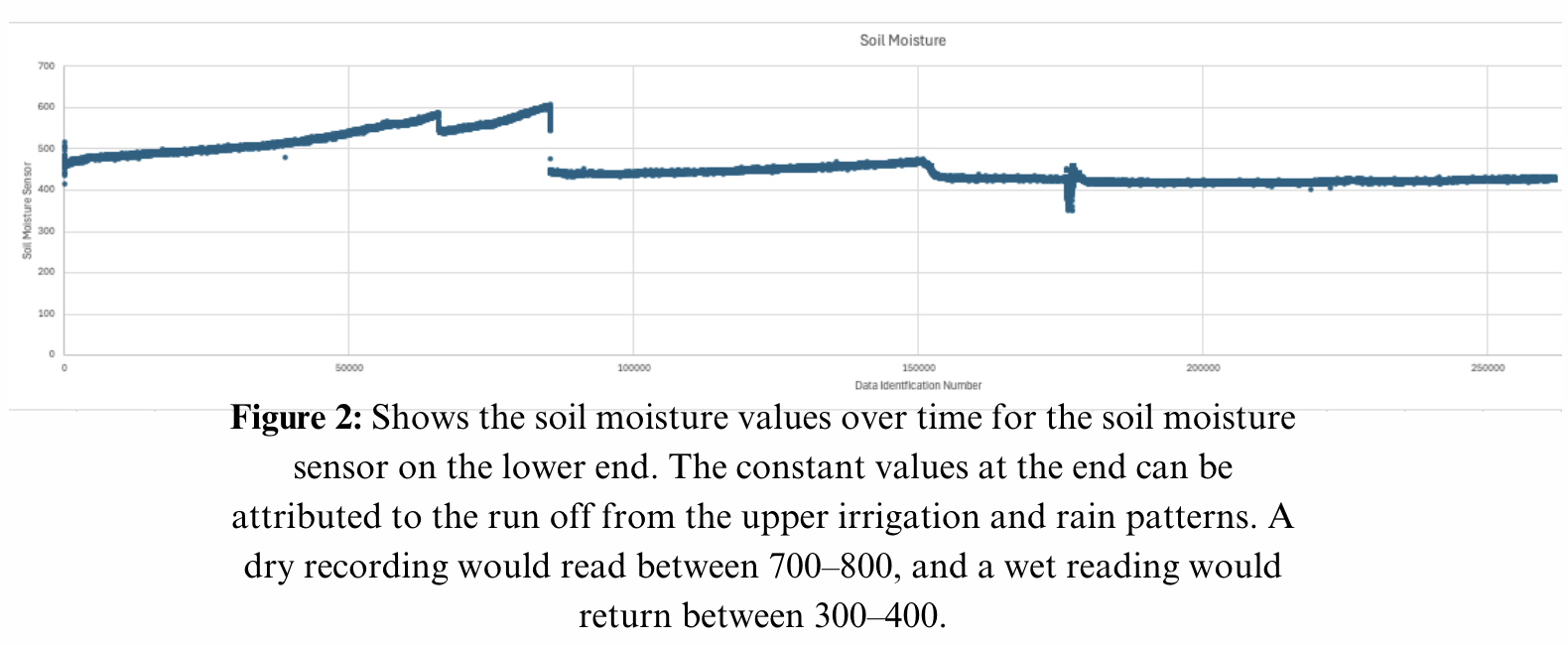
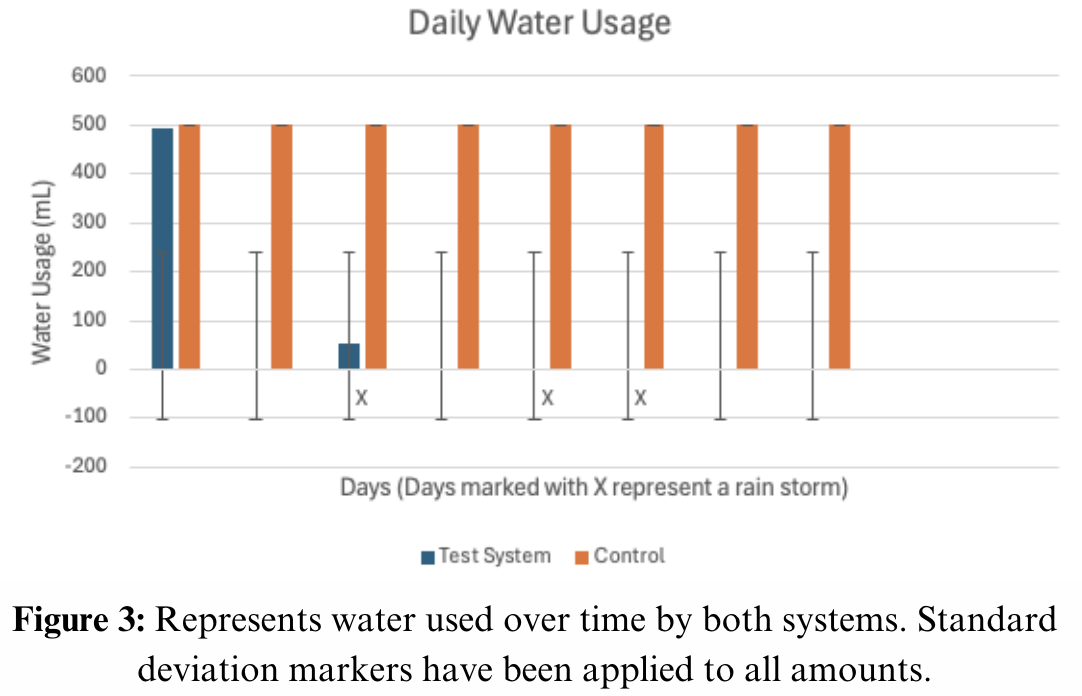
Analysis and Discussion
Our objectives were successfully accomplished. We developed and tested a device capable of interpreting weather and soil moisture data at multiple topographical levels to optimize water usage. The results, which included a low p-value (<.01), indicate that our water reduction was statistically significant and could be expected to replicate under similar testing conditions. This suggests that our approach to integrating multi-level environmental data has the ability to improve irrigation efficiency and reduce unnecessary water consumption. To validate our findings, we would like to conduct additional rounds of testing, particularly because we observed inconsistencies in data readings from the upper-end sensor. This sensor occasionally recorded values that did not align with expected environmental conditions, suggesting a malfunction with the hardware. Additionally, if this device were to be field used, we would implement several modifications to improve its durability and efficiency. One major change would be the removal of the USB storage feature, as it was responsible for a significant number of failures. These failures included unexpected data loss, flooding, and overall system malfunctions that compromised performance. Eliminating the USB component would be possible in field use if knowing the amount of water used is not essential. Furthermore, we would remove the RTC (Real-Time Clock) module. Since the USB component would no longer be necessary, the RTC would also become redundant. In addition to being unnecessary, the RTC module was a frequent source of failure—it was unreliable, often failing to communicate with the Arduino. This led to many operational failures, as the code would never progress into the main loop. Removing this module would streamline the design and improve the system’s stability. For our data analysis, we chose to use the Mann-Whitney U test because our dataset did not follow a normal distribution. A significant portion of our recorded values were zeros, while a smaller set of high values skewed the distribution. A Student's t-test would not be suitable as it has the requirement for the data to be normally distributed. The Mann-Whitney U test is well-suited for handling non-normally distributed datasets, allowing us to effectively compare our results and determine statistical significance despite the irregular distribution of values. This made it the ideal choice for our analysis. Our research and findings build upon existing irrigation systems by addressing key weak spots in current technology. Many widely used irrigation systems do not have the capability to simultaneously interpret both weather conditions and soil moisture levels across multiple topographical zones. The lack of this technology can lead to inefficient water distribution, either overwatering or underwatering crops, depending on environmental conditions. For example, current systems such as R3 Smart Sprinkler Irrigation Controller, 8 Zone (RACHIO, 2024) lack the ability to interpret soil moisture data. This means that if irrigation is scheduled without considering existing soil moisture levels, water may be applied unnecessarily, leading to waste and potential oversaturation of the soil. On the other hand, systems like Soil-Clik® Sensor (Hunter Corporation, 2025) do not account for weather data, which creates another inefficiency—these systems may irrigate fields just before a predicted rainfall event, wasting water that nature is providing.
Future Work
In the future, we would like to increase our testing population to larger farms outside as well as build weather-proof housings for these. We would also like to implement the Zambretti algorithm and look to build an onboard weather station. Having this onboard weather station would eliminate the need for a WiFi connection, allowing the system to be operated in more remote areas.
Conclusions
By integrating both weather forecast data and real-time soil moisture readings, our system aims to bridge the current market gap. The ability to interpret data at multiple topographical levels provides an additional advantage, ensuring that different sections of farmland receive irrigation aimed to their specific conditions rather than applying a uniform approach across an entire field. This precision irrigation strategy has the potential to significantly improve water conservation efforts while maintaining or even improving crop yield.
References
MSEF Poster
